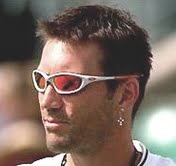The Hitting Zone
and the Hitting Arm
Pat Cash
The "hitting zone" is the swing path or area where a player's racket can make contact with the tennis ball. How does this affect the hitting arm configuration—straight or bent?
Hitting the ball with a straight arm way out front of your body diminishes your hitting zone and leaves no room for error. Slightly miss timing your stroke, a minor error in judgement, a bad bounce, or a gust of wind is likely to cause a loss of control resulting in an error.
Take a look at the Roger Federer's forehand and notice how he can't really stretch further in any direction to make contact with the tennis ball.
As you can see, Federer is at the far limit of the hitting zone. If his timing or judgment is off by just a few centimeters the shot is likely to be weak or a mistake.
A Longer Hitting Zone
With a bent arm forehand on the other hand your hitting zone is much longer. Your forehand contact point can range from parallel to your body up to 2 feet in front without losing control.
Notice how Fabio Fognini has the option to make contact with the ball further in front or further back if he has to.
This gives you a greater margin for error. You can hit the ball a little late or a bit early and still produce a successful shot without compromising control or power.
This flexibility is not only important for shot consistency (especially if you're having a bad day) but doubly important in windy conditions or when playing on inconsistent court surfaces.
Basically, a straight arm forehand lacks many of the benefits a bent arm forehand has. The result of this tends to be less control and flexibility. With a straight arm you end up with a lower margin of error and more miss hits.
I believe the drawbacks of the straight arm forehand can snowball and lead to further disruptions in your kinetic chain. For example: Because you have to hit the ball further in front some players will be more likely to adopt a neutral stance forehand. This can reduce your ability to rotate and can cause additional strain on your knee.
Still, Federer and Nadal have straight-arm forehands. What about them?
As explained above, players with a straight arm at contact point have a smaller hitting zone. Because of this they have to be incredibly good at moving and positioning their body all of the time as there is very little room for error. I think it's fair to say these players are among greats as far as movement goes. I believe that you may need this level of talent and movement to develop a great straight arm forehand.
Unfortunately for most people, this level of talent is extremely rare. So as strange as it might sound, rather than emulate them in this situation, Roger and Rafa are great examples of why you shouldn't always copy the pros.
In the 80's I clearly remember how everyone was trying to copy the serve of John McEnroe who had an unusual and extreme side on stance. Coaches and kids all over the world were experimenting. However, most forgot that McEnroe is one of the greatest talents ever--certainly the most naturally gifted player I ever played against.
The truth was that McEnroe's serve would have been great even without his side on service stance. And Roger and Rafa's forehands would be good with bent arms.
Remember, these players are among the greatest players ever and are so talented that they can compensate for the quirks and errors in their tennis technique. Even so they still require lots of practice and fine tuning to keep their forehands consistent.
The straight arm may add ball speed and rpms but it is not the sole feature that makes Roger and Rafa's forehands good. It's all the other technical stuff they are doing well combined with amazing movement and balance.
Also, keep in mind that when Nadal and Federer don't play well and lose it's often because their forehands become erratic. In fact, it's a sign commentators look for as matches get close. Their opponents know this and often build their strategy around breaking it down. Having said this, it is also a shot they depend on to play aggressively so they're playing a high risk tactics.
At the end of the day unless you are as talented and dedicated as Federer and Nadal, I suggest you stick to the bent arm forehand technique. This is especially true with club players.
Summary
Blindly emulating a player just because you like their style or they're number one in the world isn't always a good idea. Instead analyze their stroke and emulate only the best elements of their technique and ignore the rest.
Can a straight arm work consistently? For some players possibly, but in my opinion it takes a greater amount of practice and/or natural skill to do so. At the end of the day the decision is yours.
The key takeaway is a bent arm is more likely to work for you. Will it guarantee a great forehand? Obviously not. But will it maximize your chances of developing one with training? Absolutely.
Will a straight arm forehand give me more racket head speed? The reality is that these straight arm players being the most powerful group of forehands ever seen in tennis history is tempting to emulate. There is no doubt that a clean contact at maximum stretch will create enormous power.




